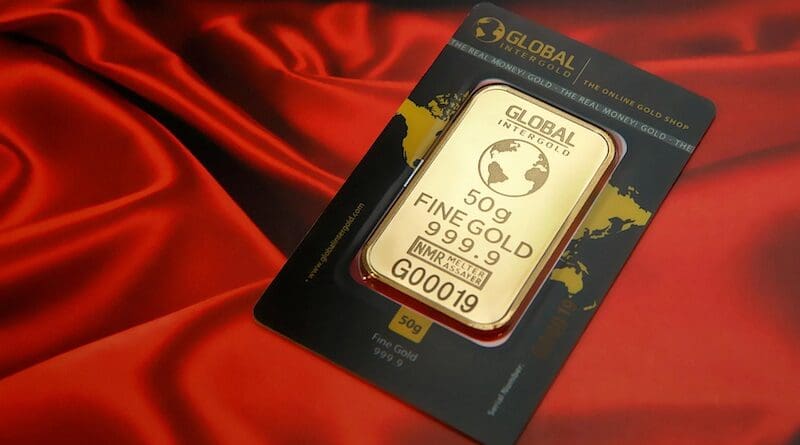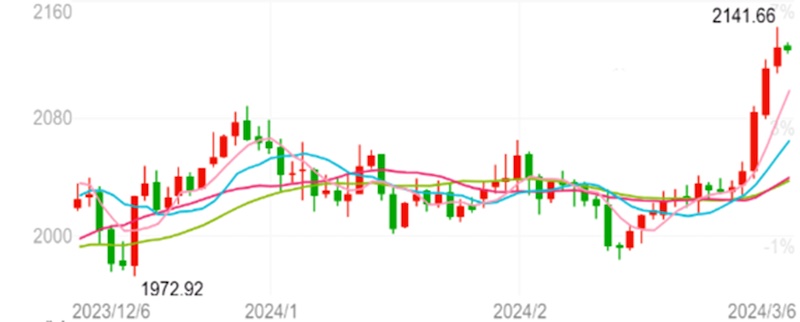Wei Hongxu

Gold price has been on a continuous rise recently, reaching a new record high in closing. In 2023, the international average gold price reached USD 1940.54 per ounce, breaking the historical record of USD 2135.4 per ounce set in December of the previous year.
Since the beginning of this year, it has remained stable above the USD 2000 per ounce mark. Since the end of February, the international gold price has once again risen rapidly, breaking through USD 2100 per ounce. On March 5, the London gold price reached a historic high of USD 2146 per ounce.
The price in RMB also hit a historical high, with the Shanghai Futures Exchange gold futures price closing at RMB 497.36 per gram on March 6, reaching a new high in the 16 years since its listing, approaching RMB 500 per gram. At the same time, with expectations of a possible interest rate cut by the Federal Reserve, many market institutions expect the future gold price to be even higher.
Citigroup stated that it could soar to USD 3000 per ounce in the next 12 to 18 months. It is stated that all of this depends on three possible catalytic factors: major central banks around the world significantly increasing gold purchases, global stagflation, or if there is a deep global recession, gold prices could rise by about 50%.
Chart: Changes in London’s Gold Prices (USD)
Currently, the continuous rise in gold prices is attributed to several factors. Firstly, there is a strong expectation for the relaxation of monetary policy by the Fed, prompting investors to reconsider the hedging function of gold. According to the latest data from the CFTC, as of February 27, the proportion of net long positions in gold has increased to its highest level in three weeks, helping investors to fully rebound from the recent lows and bet bullish on gold as a safe-haven asset. Secondly, the trend of “de-dollarization” driven by central banks around the world purchasing gold in recent years is still ongoing.
According to data from the World Gold Council, due to global uncertainty and continuous purchases by central banks, total gold demand reached a historical high of 4899 tons last year. In 2023, central banks around the world continued to purchase gold at an “astonishing pace”, with purchases totaling 1037 tons, almost on par with the record set in 2022. Thirdly, financial market volatility has made investors worried about risks. In particular, the outbreak and continuation of risks in U.S. small and medium-sized banks have posed risks and uncertainties to the stability of the financial system.
Additionally, concerns about whether last year’s rapid recovery in the U.S. capital markets can continue have led investors to worry about the possibility of asset bubbles. These factors have led to adjustments in investors’ asset allocation. Fourthly, intensified international geopolitical risks have increased investors’ demand for purchasing gold as a hedge. On the one hand, the ongoing Russia-Ukraine conflict and financial sanctions against Russia by Europe and the U.S. have questioned the credibility of the U.S. dollar in emerging market countries, increasing the motivation for central banks to hold gold reserves.
On the other hand, the outbreak of the Israel-Palestine conflict and its continuation in the Middle East, as well as the resulting crisis in the Red Sea, all indicate an escalation of geopolitical risks, increasing the demand for gold as a safe haven. Since the outbreak of the Israel-Palestine conflict in September last year, the price of gold has only begun to rise significantly, increasing by nearly USD 300. In summary, these factors mainly stem from the increase in risk aversion due to heightened market risks and uncertainties, leading to renewed favorability of gold among investors.
Although the market currently holds a generally bullish sentiment towards gold, the recent rise in gold prices differs from the past. Historically, gold, as a safe haven investment, tends to move inversely with the value of the U.S. dollar. In situations where the Fed implements monetary easing, leading to a depreciation of the USD, gold prices, denominated in USD, typically rise. However, there are distinct differences in the current rise in gold prices. Despite the Fed not ending its quantitative tightening policy and U.S. interest rates remaining high, the USD continues to be strong, with the dollar index still exceeding 100. In this scenario, gold prices have surged to historic highs, a rare occurrence since the collapse of the Bretton Woods system.
Although the market anticipates the possibility of the Fed cutting interest rates starting in June, prompting some investors to position themselves ahead of time, the sustained high price of gold may indicate that USD liquidity is still in a relatively “loose” environment. Similar to the performance of gold, cryptocurrencies, which are currently considered “alternatives” to gold, have also begun to rise again, with Bitcoin recently rapidly reaching a historic high of USD 69,000. This situation is perplexing, as it suggests that gold prices are “decoupling” from the USD despite the tightening of the currency’s liquidity. This scenario may have implications for future international capital markets and the status of the USD as the primary international reserve currency.
It is worth noting that despite the Fed tightening monetary policy, fiscal policy in the U.S. remains expansionary. Therefore, even though the magnitude and speed of Fed rate hikes have reached unprecedented levels, the contraction of USD liquidity is not as strong as expected. According to data from the U.S. Treasury Department, since reaching USD 32 trillion in June 2023, U.S. debt has surpassed USD 33 trillion just three months later, and on January 4 this year, it broke through the USD 34 trillion mark.
Bank of America analyst Michael Hartnett suggests that the rapid expansion of U.S. debt has led to the devaluation of USD credit, which has contributed to the sharp increase in asset prices such as gold and bitcoin. Hartnett predicts that at the current rate of debt growth, U.S. debt will soon reach USD 35 trillion. The debt is expected to increase by USD 18 trillion over the next ten years, reaching USD 52 trillion by 2023. With debt expanding rapidly, credit devaluation trades are nearing historical highs, indicating that financial markets are increasingly expecting long-term depreciation of the USD.
In this regard, the weakening of USD credit can be seen as a significant reason for the decoupling of gold from the currency. Of course, from the perspective of geopolitical risks, given the continuous weaponization of the USD by the U.S. and Europe to impose financial sanctions on other countries, central banks and international traders purchasing gold do so not only to maintain portfolio stability or currency stability but also to mitigate the political risks associated with the USD. Therefore, as previously discussed by researchers at ANBOUND, the geopolitical marginalization of the international monetary system can be considered a long-term factor in the decoupling of gold from the USD.
Final analysis conclusion:
On March 5, the London gold price reached a historic high of USD 2146. The RMB gold price also hit a record high. The rapid rise in gold prices since the beginning of the year can be attributed to various factors, including increased expectations of a Fed rate cut, rising purchases by central banks worldwide, instability in financial markets, and escalating geopolitical risks. However, the continued increase in gold prices amid the Fed’s tightening of monetary policy and the strengthening of the USD is noteworthy. Under the influence of USD “credit devaluation” and geopolitical factors, gold has shown a tendency to decouple from the U.S. currency.

No comments:
Post a Comment